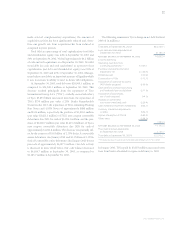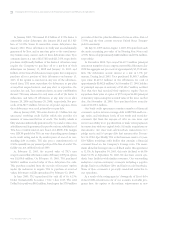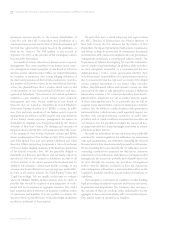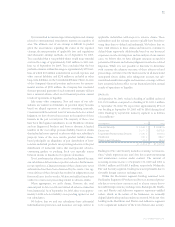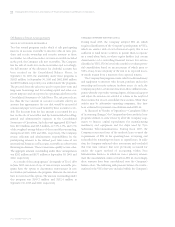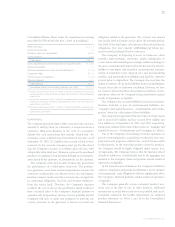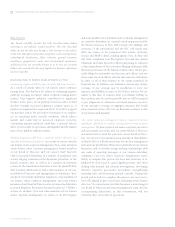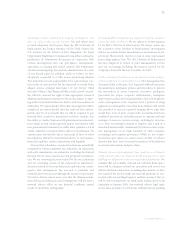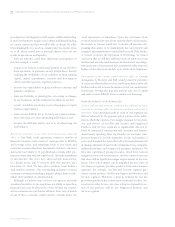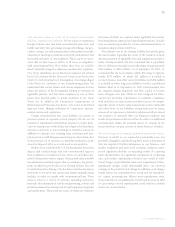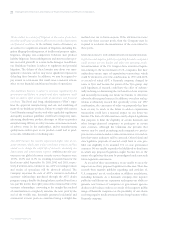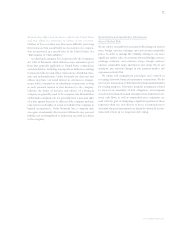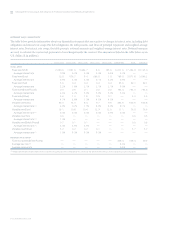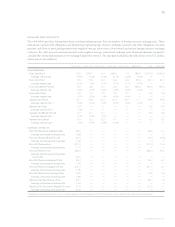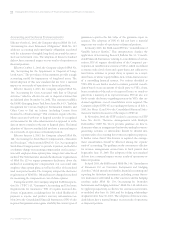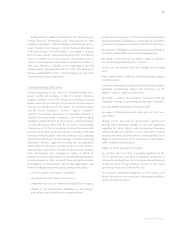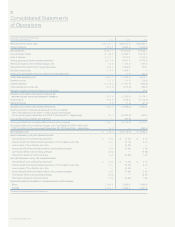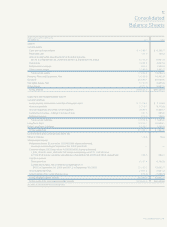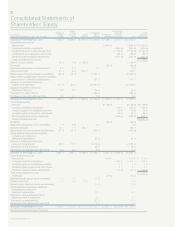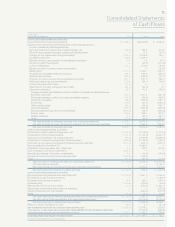ADT 2003 Annual Report Download - page 61
Download and view the complete annual report
Please find page 61 of the 2003 ADT annual report below. You can navigate through the pages in the report by either clicking on the pages listed below, or by using the keyword search tool below to find specific information within the annual report.
59
Our operations expose us to the risk of material environmental
liabilities, litigation and violations. We are subject to numerous
foreign, federal, state and local environmental protection and
health and safety laws governing, among other things: the gen-
eration, storage, use and transportation of hazardous materials;
emissions or discharges of substances into the environment; and
the health and safety of our employees. There can be no assur-
ances that we have been or will be at all times in compliance
with environmental laws. If we violate these laws, we could be
fined, criminally charged or otherwise sanctioned by regulators.
One of our subsidiaries in our Electronics segment was advised
by the U.S. Attorney for the District of Connecticut that it is the
target of a federal grand jury investigation concerning alleged
Clean Water Act violations at two manufacturing plants. We
understand that certain former and current employees at these
plants are subjects of the investigation relating to violations of
applicable permits, and that those employees at one of these
plants have pleaded guilty to felony violations of the Clean
Water Act. In addition, the Connecticut Commissioner of
Environmental Protection has filed a civil action in Hartford
Superior Court alleging violations of Connecticut environ-
mental statutes and regulations.
Certain environmental laws assess liability on current or
previous owners or operators of real property for the cost of
removal or remediation of hazardous substances at their prop-
erties or at properties at which they have disposed of hazardous
substances and costs to restore damage to natural resources. In
addition to cleanup costs resulting from environmental laws,
private parties could bring personal injury or other claims due
to the presence of, or exposure to, hazardous substances used,
stored or disposed of by us or contained in our products.
We have been notified by the U.S. Environmental Protection
Agency and certain foreign and state environmental agencies
that conditions at a number of sites where we and others dis-
posed of hazardous wastes require cleanup and other possible
remedial action and may require that we reimburse the govern-
ment or otherwise pay for the cost of cleanup of those sites and
for natural resource damages. We also have a number of projects
underway at several of our current and former manufacturing
facilities in order to comply with environmental laws. These
projects relate to a variety of activities, including radioactive
materials decontamination and decommissioning, solvent and
metal contamination cleanup and oil spill equipment upgrades
and replacement. These projects, some of which are voluntary
and some of which are required under applicable law, involve
both remediation expenses and capital improvements. In addi-
tion, we remain responsible for certain environmental issues at
manufacturing locations sold by us.
The ultimate cost of site cleanup is difficult to predict given
the uncertainties regarding the extent of the required cleanup,
the interpretation of applicable laws and regulations and alter-
native cleanup methods. We have concluded that it is probable
that we will incur remedial costs in the range of approximately
$142 million to $451 million. As of September 30, 2003, we
concluded that the best estimate within this range is approxi-
mately $270 million, of which $32 million is included in
accrued expenses and other current liabilities and $238 million
is included in other long-term liabilities on the Consolidated
Balance Sheet as of September 30, 2003. Environmental laws
are complex, change frequently and have tended to become
more stringent over time. While we have budgeted for future
capital and operating expenditures to maintain compliance
with such laws, we cannot assure you that our costs of comply-
ing with current or future environmental protection and health
and safety laws, or our liabilities arising from past or future
releases of, or exposures to, hazardous substances will not exceed
our estimates or adversely affect our financial condition and
results of operations or that we will not be subject to additional
environmental claims for personal injury or cleanup in the
future based on our past, present or future business activities.
We may be required to recognize additional impairment charges.
Pursuant to GAAP, we are required to periodically assess our
goodwill, intangibles and other long-lived assets to determine if
they are impaired. Further disruptions to our business, end
market conditions and protracted economic weakness, unex-
pected significant declines in operating results of reporting
units, the divestiture of a significant component of a reporting
unit, and market capitalization declines may result in addi-
tional charges to goodwill and other asset impairments. Future
impairment charges could substantially affect our reported
earnings in the period of such charge. In addition, such charges
would reduce our consolidated net worth and our sharehold-
ers’ equity, increasing our debt-to-total-capitalization ratio.
Such reduction in consolidated net worth and increase in debt
as a percentage of total capitalization could result in a default
under our credit facilities.
TYCO INTERNATIONAL LTD.


